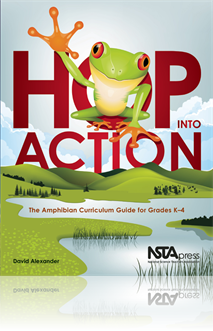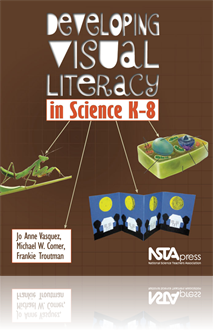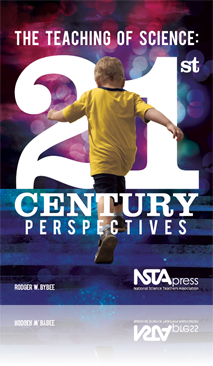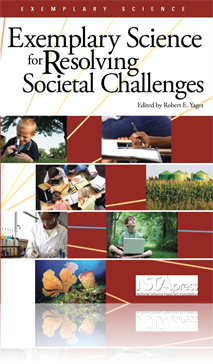All Book Chapters
Book Chapter
In this lesson, students simulate the feeding behaviors of amphibians by collecting “prey.” The objective is to identify the different feeding strategies of frogs....
Book Chapter
In this lesson, students use film canisters to follow scent trails that end at a pond or alternative final destination. The objective is for students to be able to describe how and why amphibians use their sense of small for odor communication....
Book Chapter
In this lesson, students create poetry using descriptive words from their observations. The objective is for students to be able to write poetry about amphibians....
Book Chapter
Ribbiting Discoveries in the Lily Pad Paper
In this lesson, students research interesting things about amphibians or things found around a frog pond to create a news article for the Lily Pad Paper. The objective is for students to write a journalism-style story describing the events at a frog ...
Book Chapter
In this lesson, students act as naturalists spending time documenting their observations by writing and sketching in journals over repeated sessions that span changing seasons. The objective is for students to observe broadly and focus closely to dis...
Book Chapter
In this lesson, students work in teams to create their own amphibian conservation plans. The objective is for students to develop and explain their own conservation ideas....
Book Chapter
In this lesson, students discuss and evaluate complicated decisions that take place around a frog pond habitat. The objective is for students to examine and discuss their own values around real-life environmental scenarios that involve amphibians....
Book Chapter
In this lesson, students take on the roles of various stakeholders in a town meeting. The objectives are for students to identify and describe the points of view of different stakeholders in a fictitious community dilemma, as well as develop an under...
Book Chapter
In this lesson, students explore an amphibian habitat to observe and collect data about amphibian behaviors. The objective is to identify the behaviors of amphibians in their natural habitat....
Book Chapter
In this lesson, students create art based on amphibian species and analyze how art can impact culture and how artists use issues as subjects for their work. The objectives are for students to create art that depicts amphibians and then research and ...
Book Chapter
In this lesson, students learn the life cycle of a frog through discussing and acting out their growing stages. The objective is to identify the stages of amphibians from egg to adult....
Book Chapter
Amphibians come in many shapes, sizes, and colors and can be described and identified using language that appeals to our senses of sight, touch, and hearing. When students compare different amphibians, they are more likely to think deeply about the p...
Book Chapter
In this lesson, students describe and demonstrate the movement of amphibians and reptiles through a relay race. The objective is for students to be able to describe the characteristic movements of amphibians....
Book Chapter
In this lesson, students will color and hide amphibians to learn about camouflage and use their sense of sight to search them out. The objective is for students to be able to demonstrate their knowledge of how camouflage and bright coloration are use...
Book Chapter
In this lesson, students move through an outside area or school hallway to discover picture cards with messages that describe migration challenges. The objectives are for students to be able to describe migration as a regular seasonal movement and id...
Book Chapter
In this lesson, students discuss the ingredients that make up a healthy frog pond. The objective is for students to be able to describe the components of a frog pond to include living parts—plants and animals—and nonliving parts—water, air, so...
Book Chapter
In this lesson, students create a list of living and nonliving things found within a frog pond habitat and discuss their relationships to each other through the creation of a simulated web using a ball of yarn. The objective is for students to be abl...
Book Chapter
Visual Literacy in Earth Science: Phases of the Moon
Chapters 6, 7, and 8 are practice chapters. Each chapter provides the appropriate content standards for grades K-4 and 5-8 and several partial lessons and each follows the same format but addresses a different content area. This chapter addresses Ear...
Book Chapter
A Perspective on the Reform of Science Teaching
This chapter presents a perspective on reform. It begins with a brief review of the instructional core, then turns to a larger view of reform, one that includes broader questions of goals and progresses to the most fundamental area—classroom practi...
Book Chapter
The Teaching of Science: Contemporary Challenges
This chapter introduces the subsequent chapters with major themes and an emphasis for the book. It also sets forth the themes of curriculum and instruction as they relate to science teachers. ...
Book Chapter
The Teaching of Science Content
This chapter presents the ideals and spirit of Paul F-Brandwein. In particular, it brings contemporary ideas to themes that he presented almost 50 years ago. Those themes include the substance of science education, curricular structure, and the style...
Book Chapter
The Science Curriculum and Classroom Instruction
This chapter uses the major contributions of Bob Karplus to develop several important themes that have emerged in the past five decades of curriculum and instruction in science. The chapter begins with a perspective on curriculum development and curr...
Book Chapter
The 2008 Robert H. Carleton Lecture provides the content for Chapter 4. The chapter centers on the themes of teaching science as inquiry. After a brief introduction to the history of inquiry in science education, the national standards are used as t...
Book Chapter
Science Teaching and Assessing Students’ Scientific Literacy
This chapter introduces some dimensions of scientific literacy and describes PISA, the Program for International Student Assessment, as the basis for understanding scientific literacy from both teaching and assessment perspectives. Most science educa...
Book Chapter
Fulfilling National Aspirations Through Curriculum Reform
This chapter and chapter 7 provide contemporary perspectives on the response of science education to national priorities and goals. This theme is explored with reflections from the Sputnik era of curriculum reform. Reflecting on the Sputnik era provi...
Book Chapter
Teaching Science as Inquiry and Developing 21st-Century Skills
Contemporary national aspirations also include maintaining economic competitiveness. The economic theme is a relatively short-term goal, and for science education it implies preparation of a 21st-century workforce. For the science teacher, this aspir...
Book Chapter
The authors contend that preservice training in Project-Based Science (PBS) facilitates early faithful implementation of PBS, which in turn provides students with the opportunity to engage in the public discourse and debate advocated in Goals 2000 Ob...
Book Chapter
Using Socioscientific Issues as Contexts for Teaching Concepts and Content
This chapter focuses upon the conceptual development and implementation of a socioscientific issues (SSI) curriculum in two high school science classrooms. The scenarios and perspectives described in this chapter exemplify fundamental examples of be...
Book Chapter
Securing a “Voice”: The Environmental Science Summer Research Experience for Young Women
Roland Park Country School is an urban college preparatory school for students in grades K–12 located in Baltimore, Maryland. An independent all-girls school, the institution maintains a commitment to community outreach to address issues of equity ...
Book Chapter
Two settings build the premise for this chapter and comprise the Connecting Humans and Nature through Conservation Experiences (CHANCE) program. The first setting is a summer field course in Costa Rica and the second is the regular school classroom d...
Book Chapter
Engaging Students in Content Learning and Scientific Critique Through a Nanoscience Context
Nanoscience is increasingly visible in scientific endeavors, new technologies, and engineered products. Citizens and students must develop a sense of what constitutes scientific evidence of the positive and negative effects as well as side effects o...
Book Chapter
As in many other education jurisdictions, environmental education in Ontario is infused throughout the science curriculum. This infusion requires students to not only understand the science behind environmental issues, but also be provided with “me...
Book Chapter
An “HOLA” Approach to Learning Science
Implementing classroom instructional strategies that lend themselves to both unidimensional assessments and alternative assessments provide evidence of proficiency that can satisfy both school and student learning evaluations. Barnard Environmental M...
Book Chapter
Project-Based After-School Science in New York City
In this chapter, the authors report on how inner city high school students learn science through participation in an after-school science program called Explore! Project-based science instruction (PBSI) was used as the main method of instruction in w...
Book Chapter
Students as Scientists: Guidelines for Teaching Science Through Disciplinary Inquiry
Teaching Science as Inquiry (TSI) provides a foundation for engaging both teachers and students in disciplinary inquiry. This chapter describes a framework of teaching and learning developed to help overcome the difficulty in teaching the disciplinar...
Book Chapter
“Who Ate Our Corn?” We Want to Know and So Should You!
“Who ate our corn?” sounds like a simple enough question but is designed to intrigue students and launch them on a quest to find answers and to ask more questions. That is the goal of the Future Scientists Program featured in this chapter. The Fu...
Book Chapter
Applications of Biology as Part of a Preservice Program for Science Teachers
The Applications of Biology course provides students with the opportunity to apply scientific information in making decisions about real-world issues. Within the context of the course, students are introduced to an applications approach, with as many...
Book Chapter
Goal 3 of the National Science Education Standards (NSES) calls for students to “engage intelligently in public discourse and debate about matters of scientific and technological concern” (NRC 1996, p. 13). The unit described in this chapter, “...
Book Chapter
Tahoma Outdoor Academy: Learning About Science and the Environment Inside and Outside the Classroom
Taking students outside of the classroom is recognized as a valid and important pedagogical practice; however, teachers at all levels feel challenged when faced with integrating informal, outdoor, and community settings with subject-specific curricul...
Book Chapter
Developing Students’ Sense of Purpose With a Driving Question Board
The Driving Question Board (DQB) is an organizing tool used in the project-based curriculum described in this study, which serves as a visual organizer for all the curriculum’s contextualizing features. In this chapter, the authors report on the pi...







